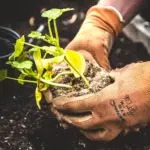
At a time when sustainability and environmental protection are becoming increasingly important, renewable resources and innovative materials are coming into focus. One promising approach that is revolutionising both the construction and packaging industries is the use of materials from algae. These sustainable materials made from algae offer a range of benefits, from environmental conservation to biodegradability of the products.
What are the different types of materials from algae?
Materials made from algae can be broadly divided into two main categories: Building materials and packaging materials. Algae can also be used for applications in the textile industry, but that is a different category of material and will only be briefly addressed in this blog.
Building materials made from algae, such as algal concrete, are used for the construction of buildings and infrastructure. For example, algae can be used as an admixture to concrete to reduce environmental impact and increase strength. Such building material helps to realise sustainable and more environmentally friendly buildings.
Packaging materials made from algae, such as bioplastics made from algae, are used in everyday life for packaging food and other products. One example is biodegradable food packaging made from algae, which replaces conventional plastic packaging. This algae packaging helps reduce the environmental impact of single-use packaging and is a more sustainable alternative for consumers.
As mentioned, algae can also be used as a material in the textile and fashion industry. In particular, extracts from algae can be used as a natural and environmentally friendly dyeing agent for various colours.
What packaging materials can be made from algae and what role do algae play in them?
Packaging materials from algae are a promising alternative to conventional plastic packaging and can be produced in various ways to replace conventional packaging materials.
Algae are already used to produce biodegradable bioplastics. These bioplastics made from algae can be used for a wide range of packaging, including disposable tableware, carrier bags and more. Microalgae as well as macroalgae play a crucial role by serving as a raw material for the production of biodegradable plastics that help reduce the environmental impact of conventional plastics.
Another packaging material that can be made from algae is algae paper. This paper can be used for packaging, labels and printing purposes. One example is the macroalgae Ulva sp., which can serve as a fibre material in paper production, providing a sustainable alternative to wood fibres.
In addition to bioplastics and algae paper, algae are also used to produce special food packaging. These methods of storing food are biodegradable. For example, they can be used in the form of Porphyra umbilicalis sheets to wrap sushi rolls, or as packaging for algae chips and snacks.
Extracts from algae can be used to produce coatings for packaging, such as water-repellent coatings from algae extracts for paper or cardboard. These coatings can improve the shelf life of packaging and make it more environmentally friendly. An example of an extract from algae that can be used for this purpose is Sodium Alginate.
Algae can play a crucial role in the production of these packaging materials as they serve as a renewable resource and help reduce dependence on non-renewable raw materials, such as petroleum. In addition, many of these materials are more biodegradable and can help alleviate the problem of plastic pollution in the environment.
What building materials can be made from algae and what role do algae play in them?
Algae can be used as sustainable raw materials in various building materials and construction materials. This use of algae is part of the trend towards developing environmentally friendly and sustainable building products. In this context, materials from algae can serve as binders, consolidants or reinforcing materials.
A concrete example of this is the production of bio-concrete, incorporating algae in the mix. This sustainable concrete can be used as a binder to reduce conventional cement. Algae contribute to the consolidation and reduce the carbon footprint of the concrete. In researching formulations, successful tests have been conducted with macroalgae such as Ascophyllum nodosum, as well as microalgae such as Coccolithophores sp.
Algae can be integrated into the production of bricks to increase their strength and improve the efficiency of thermal insulation. This can lead to more energy-efficient buildings, which in turn has a positive impact on the environment. The company is particularly known for this which, among other things, produces innovative organic bricks from microalgae.
Algae can be used in sustainable insulation materials. These materials serve to reduce heat transfer and thus lower energy consumption in buildings. Macroalgae such as Ulva intestinalis can be used as insulation material due to their low density. Macroalgae naturally contain minerals that make them more resistant to infestation by moulds and bacteria. This allows the product to remain free of artificial pollutants and chemicals.
The role of algae in these building materials is manifold. In addition, in many cases, algae help to improve the sustainability of building materials by reducing the use of non-renewable resources and lowering CO2 emissions. This contributes to the development of more environmentally friendly building products that can help reduce the ecological footprint of the construction industry.
What are the benefits of materials made from algae?
Materials made from algae offer a promising range of benefits that support a sustainable future in the construction industry. The production of such materials takes into account crucial environmental aspects, as algae act as a renewable resource and actively contribute to removing CO2 from the atmosphere. This contributes to the reduction of the greenhouse effect and reduces the ecological footprint compared to conventional materials such as plastic or cement. New material properties made possible by the integration of algae open up a wide range of applications in the construction industry. The materials can be adapted to specific requirements and have improved strength, flexibility and insulation properties.
A particular advantage is the sustainable degradability of materials from algae. They can be engineered to decompose over time without leaving harmful residues. This makes them ideal for products and constructions that are not designed to last indefinitely, such as disposable packaging or temporary structures.
A significant difference to other methods of producing sustainable materials, such as bioplastics from corn starch, is that algae do not take up bio-resources that could otherwise be used to feed the population. This minimises potential conflicts between the production of materials and the food supply and ensures that algae are a resource-efficient and environmentally sound alternative. All in all, materials made from algae offer a promising perspective for a more sustainable and environmentally friendly construction industry.
Which algae are the most ecological for the production of materials made from algae?
The most ecological algae for the production of materials from algae are those that meet certain criteria to minimise environmental impact. These include invasive or overly dominant algae species, but also by-products of algae harvesting or processing.
Algae that are too abundant in some places or are considered invasive species can be used for the sustainable production of the materials from algae. One example is the green algae Ulva lactuca, which is proliferating in some places such as Brittany in France. Harvesting and using such algae can help reduce ecological disturbances caused by excessive algal growth while providing resources for sustainable materials.
Harvesting and processing algae often produces by-products that can be used ecologically. These by-products can be used, for example, as binders for materials from algae, which contributes to a sustainable circular economy and minimises waste.
It is important to note that the selection of algae species and the methods for algae harvesting and processing need to be carefully planned to ensure that the use of materials from algae is ecologically sustainable. This includes consideration of ecological impacts on marine ecosystems, recovery of harvesting sites and protection of biodiversity.
Materials from algae – a viable alternative for the future
Materials from algae represent a promising and sustainable alternative. In the construction industry, algae help reduce CO2 emissions and offer improved strength and insulation. These materials are environmentally friendly and promote sustainability.
In packaging, materials made from algae replace conventional plastics and reduce environmental impact. They are biodegradable and improve the shelf life of packaging. Environmental sustainability can be additionally strengthened by the use of invasive algae species and the recycling of by-products. Materials made from algae offer multiple benefits, including reduced environmental impact and conservation of bio-resources.
All in all, algae-based materials are a promising and viable solution for a more sustainable construction and packaging industry.
Sources
https://www.technologynetworks.com/applied-sciences/news/algae-could-produce-our-future-building-materials-362985
https://time.com/6192603/algae-plant-buildings-carbon/
https://www.dezeen.com/2022/06/07/prometheus-biocomposite-cement-blocks/
https://www.sciencedirect.com/science/article/pii/S0964830523000318
https://www.sciencedirect.com/science/article/abs/pii/S2211926421001193
https://www.ncbi.nlm.nih.gov/pmc/articles/PMC8745059/
https://www.sciencedirect.com/science/article/pii/S2666498420300570
https://bioresources.cnr.ncsu.edu/resources/potential-use-of-green-alga-ulva-sp-for-papermaking/
https://www.intechopen.com/chapters/41116
https://www.sciencedirect.com/science/article/abs/pii/S0141813023009364
https://www.dezeen.com/2022/07/29/algae-grown-limestone-route-carbon-negative-concrete-architecture-news/#







Comments by Pit Wagner